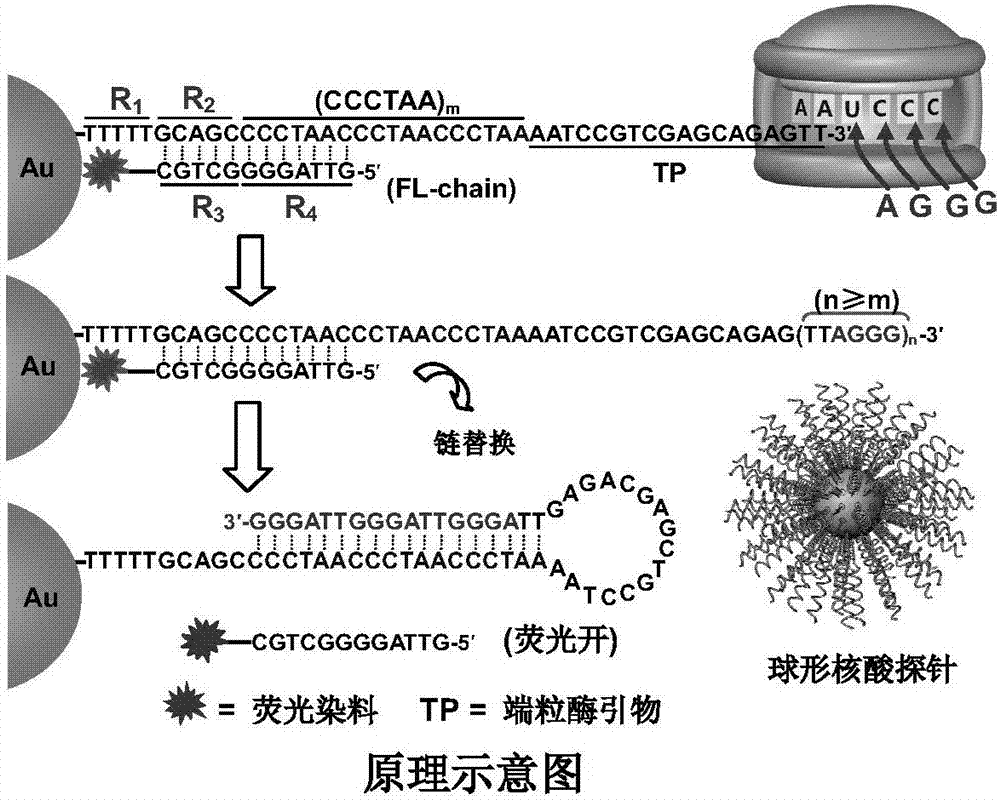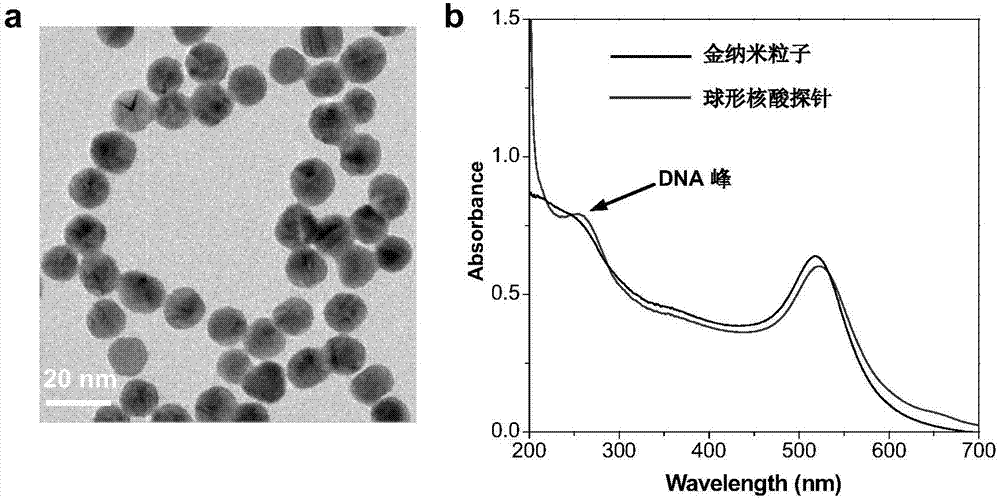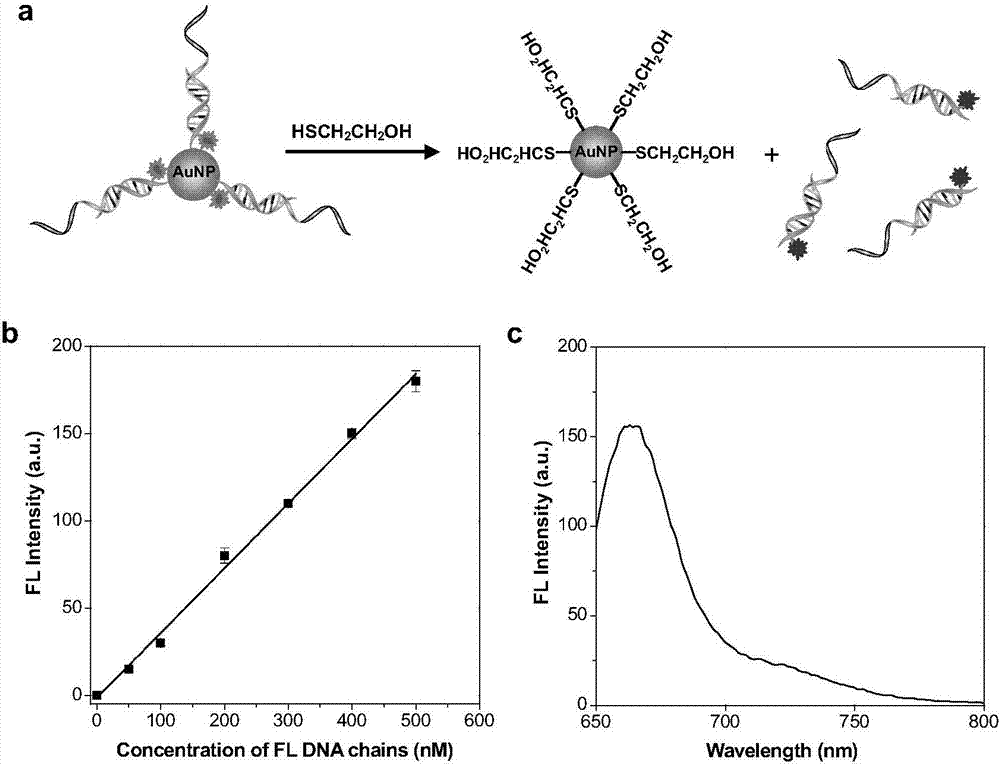Spherical nucleic acid fluorescent probe for telomerase activity detection and preparation method and use thereof
A fluorescent probe and activity detection technology, which is applied in the field of analysis and detection and medical diagnosis, can solve the problems of low transfection efficiency and high toxicity, and achieve the effects of increasing application range, preventing agglomeration, and low cost
- Summary
- Abstract
- Description
- Claims
- Application Information
AI Technical Summary
Problems solved by technology
Method used
Image
Examples
Embodiment 1
[0055] 1. Preparation of gold nanoparticles
[0056] Gold nanoparticles were synthesized by reducing chloroauric acid with sodium citrate. 100mL containing 0.01wt% aqueous solution of chloroauric acid was heated to boiling, 3.5mL concentration of 1wt% sodium citrate solution was added rapidly under the situation of vigorous stirring, continued heating and reflux stirring for 10 minutes, stopped stirring, and naturally cooled to room temperature to obtain Gold nanoparticles solution (morphology see figure 2 a), store in a 4°C refrigerator for later use.
[0057] 2. Preparation of spherical nucleic acid fluorescent probes
[0058] Mix the TP-chain long chain and Cy5 dye-modified FL-chain short chain at a molar ratio of 1:1, heat to 90°C for 5 minutes, then cool down to room temperature naturally to obtain hybrid double-stranded DNA; Double-stranded DNA was added to the gold nanoparticle solution prepared in step 1 at a molar ratio of 300:1, shaken at room temperature for 16 ...
Embodiment 2
[0068] Example 2: Detection of Intracellular Telomerase Activity
[0069] combine Figure 7-10, Imaging Intracellular Telomerase Activity Using Spherical Nucleic Acid Probes. Using HeLa cells as the basic model, HeLa cells were planted in confocal culture dishes and cultured for 24 hours. Then 50 μL of probe (6 nM) was added to the culture dish and incubated for 2 h, and imaged by laser confocal fluorescence microscope. In telomerase-positive HeLa cells, the FL-chain was replaced and the fluorescence recovered, so the fluorescence signal in the cytoplasm could be seen on the confocal microscopy images. The telomerase inhibitor 3′-azidovudine was co-cultured with HeLa cells for 48 hours, then 50 μL of probe was added and cultured for 2 hours. Observation with a laser confocal fluorescence microscope showed that the intracellular fluorescence signal was significantly reduced, indicating that the intracellular Telomerase activity was inhibited by telomerase inhibitors ( Figu...
Embodiment 3
[0070] Example 3: Labeling of Tumor Cells in Human Peripheral Blood
[0071] to combine Figure 11-13 , tumor cell HeLa and normal cell MRC-5 were planted in a culture dish respectively, and after culturing for 24 hours, 50 μL (6 nM) were added and cultured for 2 hours. Different proportions of HeLa and MRC-5 cells were mixed and the fluorescent signals were detected by flow cytometry. Tumor cells and normal cells doped in different proportions could be well distinguished ( Figure 11 , 12 ). On this basis, HeLa cells were planted in 20mm culture dishes and cultured for 24h. Then 50 μL of the probe was added to the dish and after 2 h of incubation, the cells were trypsinized and resuspended in 1 mL of PBS buffer. Take out 5 cells and mix them in 50 μL of human peripheral blood without red blood cells, collect the cells with a flow cytometer and detect the signal. The 5 cells mixed in the peripheral blood can be detected. In the experiment of doping 10 cells 9 ( Figure 1...
PUM
 Login to View More
Login to View More Abstract
Description
Claims
Application Information
 Login to View More
Login to View More - R&D
- Intellectual Property
- Life Sciences
- Materials
- Tech Scout
- Unparalleled Data Quality
- Higher Quality Content
- 60% Fewer Hallucinations
Browse by: Latest US Patents, China's latest patents, Technical Efficacy Thesaurus, Application Domain, Technology Topic, Popular Technical Reports.
© 2025 PatSnap. All rights reserved.Legal|Privacy policy|Modern Slavery Act Transparency Statement|Sitemap|About US| Contact US: help@patsnap.com



